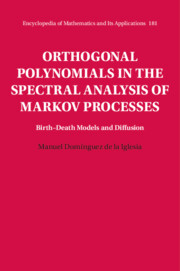 Orthogonal Polynomials in the Spectral Analysis of Markov Processes
Orthogonal Polynomials in the Spectral Analysis of Markov Processes References
Published online by Cambridge University Press: 08 October 2021
Summary

- Type
- Chapter
- Information
- Orthogonal Polynomials in the Spectral Analysis of Markov ProcessesBirth-Death Models and Diffusion, pp. 322 - 330Publisher: Cambridge University PressPrint publication year: 2021


